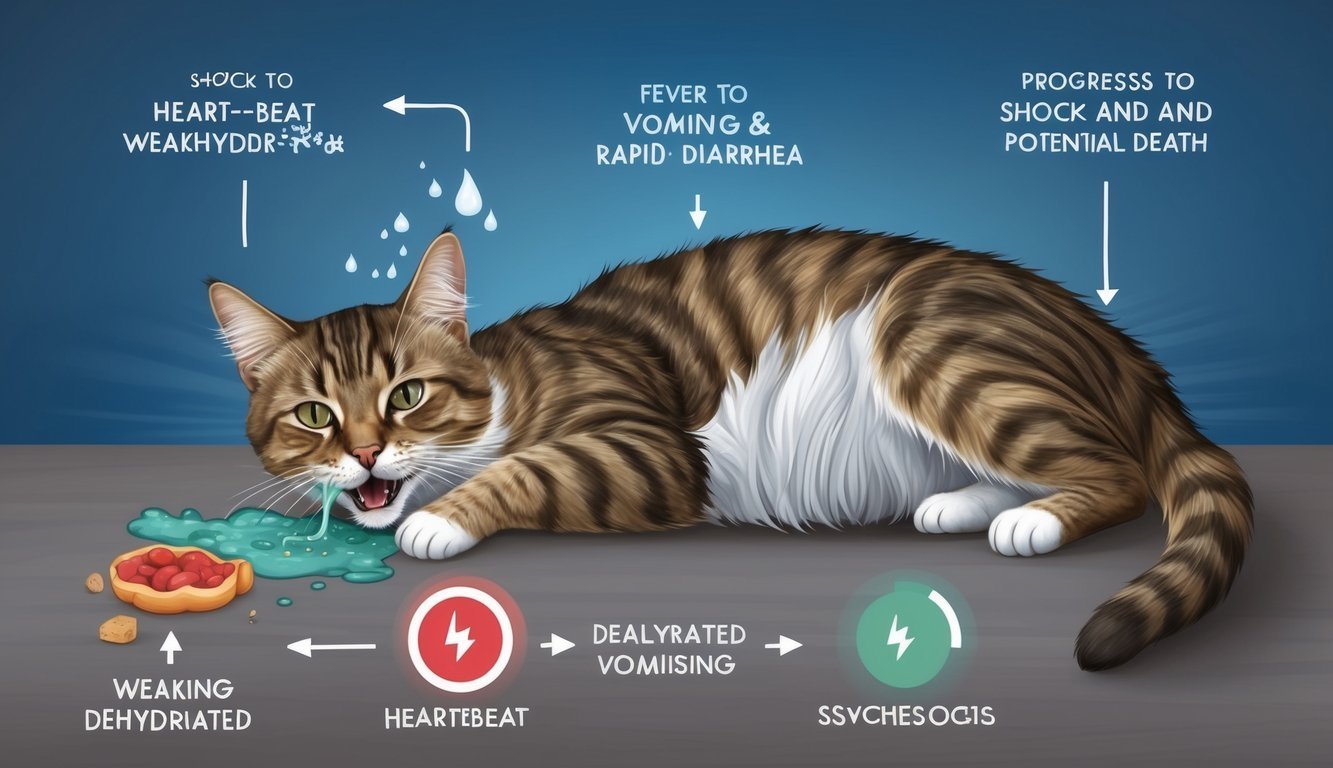Feline parvovirus, or parvo, is a serious viral infection that can dramatically affect your cat’s health.
Understanding the stages of parvo can help you recognize symptoms early, enabling timely veterinary intervention.
Many cat owners may not realize how quickly the virus can progress, making it crucial to stay informed about the signs to watch for.
From initial exposure to the advanced stages of the disease, parvovirus can impact your cat’s well-being in various ways.
Symptoms often begin with gastrointestinal distress and can lead to more severe complications if not addressed promptly.
Knowing what to expect throughout the progression of the disease can be vital for effective treatment and recovery.
By familiarizing yourself with the stages of parvo and the specific signs associated with each phase, you can better protect your feline friend from this potentially life-threatening condition.
It’s essential to stay vigilant and proactive in monitoring your cat’s health.
Key Takeaways
- Early detection of symptoms can significantly improve treatment outcomes.
- Understanding the stages of parvo helps in timely diagnosis and care.
- Vaccination is key to preventing feline parvovirus infection.
Understanding Parvovirus in Cats
Feline parvovirus, also known as the panleukopenia virus, is a serious and contagious disease affecting cats, especially kittens.
Understanding its nature, how it compares to canine parvovirus, and how it spreads can help you keep your cat safe.
The Nature of Feline Parvovirus
Feline parvovirus (FPV) is a highly contagious virus that primarily targets the gastrointestinal tract of cats.
It leads to severe symptoms like vomiting, diarrhea, and significant dehydration.
The virus can cause feline infectious enteritis, which may ultimately be fatal, particularly in unvaccinated kittens.
FPV harms rapidly dividing cells, affecting both the intestinal lining and bone marrow, leading to a decrease in white blood cells.
This can compromise your cat’s immune system significantly.
Vaccination is crucial in preventing FPV.
Keeping your cat up to date with vaccinations can protect them against this dangerous virus and help reduce outbreaks in multi-cat environments.
Feline Parvovirus Versus Canine Parvovirus
It’s essential to note that feline parvovirus is distinct from canine parvovirus.
While both viruses cause severe gastrointestinal symptoms in their respective species, they are not interchangeable.
Your cat cannot contract feline parvovirus from dogs.
Instead, the similar virus affecting dogs is known as canine parvovirus-2 (CPV-2).
Understanding this difference can alleviate concerns you might have about your cat contracting parvo from canine companions.
Both viruses share similarities in their transmission routes and severity, which is why they are often compared.
Ensuring vaccinations specific to each species is vital for preventing these illnesses.
How Parvovirus Spreads Among Cats
Feline parvovirus spreads primarily through direct contact with an infected cat or contaminated surfaces.
The virus can survive in the environment for long periods.
Fomites, such as food bowls, bedding, and even your shoes, can harbor the virus.
It’s crucial to maintain a clean environment, especially in homes with multiple cats.
Additionally, FPV can also be spread through fecal matter and saliva, making hygiene practices important.
If you have an infected cat, it’s best to isolate them to prevent spreading the virus to healthy cats in your home.
Symptoms and Progression of Parvo in Cats
Recognizing the symptoms and progression of parvo in cats is crucial for timely intervention.
The disease can escalate rapidly, so being aware of the early signs, progressive symptoms, and severe manifestations can make a significant difference in your cat’s health.
Early Signs of Infection
The initial symptoms of feline parvovirus can appear between 7 to 14 days after exposure.
Early signs often include loss of appetite, which may lead to rapid weight loss.
You might notice your cat being more lethargic than usual, showing a lack of energy or enthusiasm for activities they previously enjoyed.
Vomiting and mild diarrhea may also occur, along with a potential fever.
Monitor your cat for changes in behavior and appetite, as these are key indicators of infection.
It’s vital to act quickly if you observe these early signs, as prompt veterinary evaluation is essential for effective treatment.
Progressive Symptoms
As the infection advances, symptoms can become more severe.
Your cat may experience frequent vomiting and diarrhea, which can lead to dehydration.
You might find that the diarrhea becomes more intense, possibly containing blood.
Increased depression is often noted during this stage; your cat may isolate itself or hide more frequently.
A blood test may show lower levels of white blood cells, indicating a compromised immune system.
These progressive symptoms often signal the need for urgent veterinary care to prevent further complications.
Severe and Late-Stage Symptoms
In the late stages of parvovirus infection, symptoms can become critical.
Your cat may exhibit severe dehydration due to ongoing vomiting and diarrhea.
The fever may spike, while lethargy intensifies to the point where your cat might not respond to stimuli.
This stage can also see significant blood loss in the stool, which is alarming.
A veterinary blood smear can reveal further details about your cat’s condition, as the virus attacks rapidly dividing cells.
Immediate veterinary intervention is necessary to address these severe symptoms and manage complications effectively.
Diagnosis and Detection
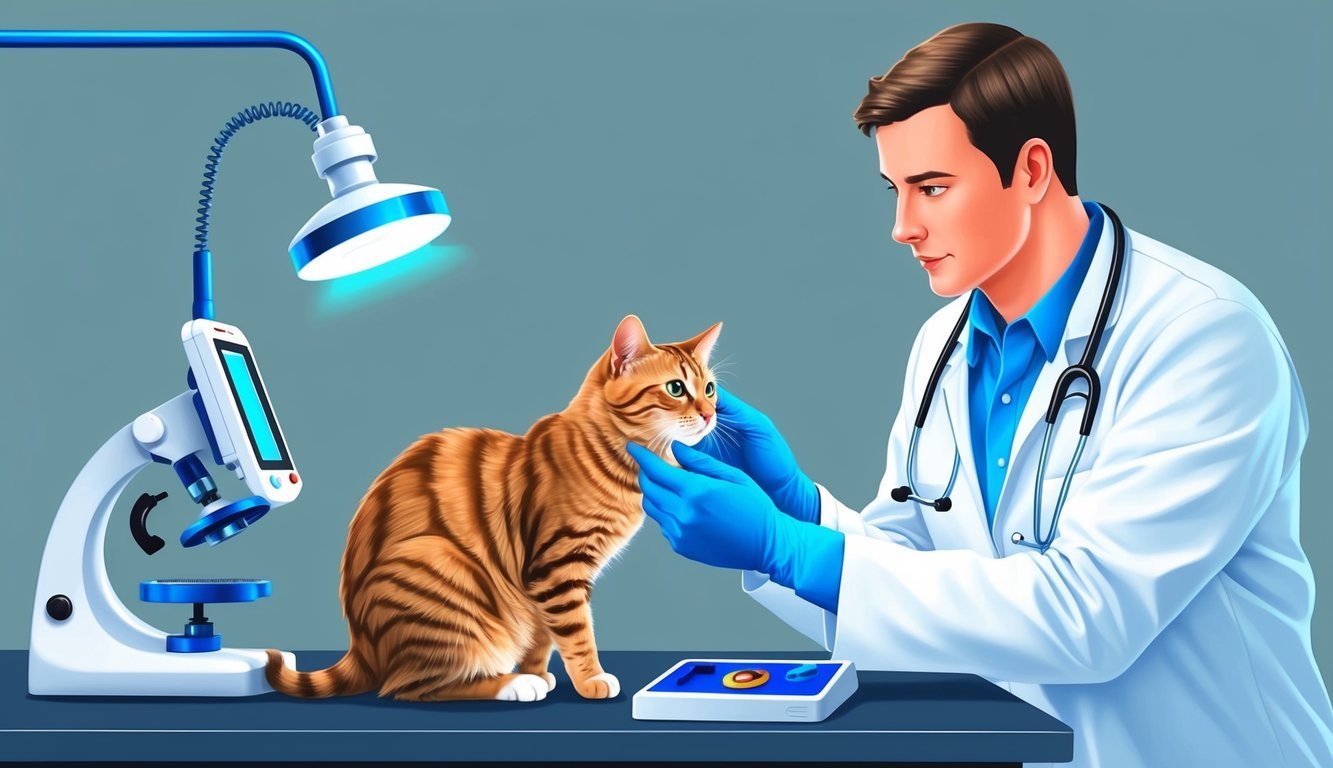
Recognizing parvovirus in cats early can significantly improve the chances of a successful treatment.
Understanding the clinical signs and utilizing proper laboratory tests play a crucial role in diagnosing this disease.
Clinical Signs and Vet Examination
When you take your cat to the vet, be prepared to discuss any symptoms you’ve observed.
Common clinical signs include:
- Severe vomiting: This can often lead to dehydration.
- Diarrhea: Look for watery or bloody stools.
- Loss of appetite and lethargy: These may indicate a serious issue.
During the examination, the vet will assess your cat’s body temperature and general condition.
They may also check for an increased heart rate, which is a sign of dehydration.
If your cat shows a low white blood cell count, it can be a strong indicator of parvovirus, as the virus attacks rapidly dividing cells, including white blood cells.
Laboratory Tests and Confirmation
To confirm a parvovirus diagnosis, your vet may perform several laboratory tests.
Common procedures include:
- Blood smear: This can reveal abnormalities in your cat’s blood cells.
- Fecal tests: Checking for the presence of the virus in your cat’s stool is a key diagnostic tool.
- Necropsy: In severe cases where a cat has died, a necropsy can provide definitive evidence of parvovirus infection through tissue examination.
These tests help in accurately diagnosing parvovirus infection and differentiating it from other gastrointestinal issues.
Early and precise detection is vital for effective treatment and better outcomes for your feline friend.
Treating Feline Parvo
When dealing with feline parvovirus, timely treatment is crucial for your cat’s recovery.
You should focus on immediate care, ensuring proper supportive treatments, and preventing secondary infections.
Immediate Care and Isolation
As soon as you suspect your cat has parvo, it’s essential to isolate them.
This helps prevent the spread of the virus to other pets.
Keep your cat in a quiet, comfortable area away from other animals.
Monitoring your cat’s condition is vital.
Look for signs like vomiting, diarrhea, and lethargy.
Contact your veterinarian immediately if symptoms arise.
They may recommend a visit to the clinic for further assessment.
Maintaining cleanliness in your cat’s environment is critical.
Use disinfectants that are effective against parvovirus to reduce contamination risks.
Quarantine any new animals in your home until you are sure they are healthy.
Supportive Treatments and Fluid Therapy
Supportive care is a cornerstone of treating feline parvo.
Intravenous fluids are often necessary to prevent dehydration.
This treatment replaces lost fluids and helps stabilize your cat.
Your vet may also suggest providing a high-quality, easily digestible diet.
In some cases, they might administer medications to control vomiting or nausea.
This can encourage your cat to eat and regain strength.
Regular monitoring of hydration levels is crucial during treatment.
Check for signs of dehydration, such as dry gums or sunken eyes.
Adjusting fluid therapy based on your cat’s needs can make a significant difference in recovery.
Antibiotics and Secondary Infections
Feline parvovirus can weaken the immune system, making your cat vulnerable to secondary infections.
To combat this risk, your veterinarian may recommend antibiotics.
These medications help prevent bacterial infections in your cat’s weakened state.
It’s important to follow your vet’s dosage instructions carefully.
Completing the entire course of antibiotics is essential for effectiveness.
Discuss any side effects with your veterinarian to ensure proper management.
In addition to antibiotics, keep your cat’s environment clean and free from potential contaminants.
Regularly disinfect areas where your cat spends time, and maintain strict hygiene practices during recovery.
Preventing the Spread of Parvovirus

To effectively prevent the spread of parvovirus in your cat population, focus on proper vaccination, rigorous disinfection practices, and effective infection control in multi-cat environments.
Each method plays a critical role in safeguarding your cats from this severe illness.
Vaccination Protocols
Vaccination is your first line of defense against feline parvovirus.
Ensure that your kittens receive their FVRCP vaccine, which protects against various diseases, including parvovirus.
- Schedule: Begin vaccinations at about 6-8 weeks of age. Follow up with booster doses every 3-4 weeks until they are 16 weeks old.
- Adult Cats: Don’t overlook adult cats; they should receive booster vaccinations every 1-3 years, depending on your veterinarian’s advice.
Staying on top of vaccination schedules is crucial to ensure your furry friends are protected before they encounter the virus.
Quarantine Measures and Disinfection
If you suspect an outbreak or if a cat has been diagnosed with parvovirus, immediate quarantine is essential.
Isolate infected cats from healthy ones to prevent transmission.
- Isolation: Keep them in a separate area and limit contact with people and other pets.
Disinfection is equally important.
Use appropriate disinfectants, like bleach solutions (1:32 dilution), to clean surfaces and toys that may have come into contact with the virus.
- Cleaning Surfaces: Focus on floors, bedding, and feeding equipment.
- Frequency: Regularly clean and disinfect areas where cats play or rest.
These measures will significantly reduce the risk of spreading the virus.
Controlling Infection in Multi-Cat Environments
If you have multiple cats, maintaining a safe environment is crucial.
Implement strict vaccination protocols for all cats entering your home, especially in multi-cat households or catteries.
-
New Arrivals: Always quarantine new cats for at least two weeks before introducing them to your existing cats.
-
Monitoring Health: Keep a close eye on their health. If you notice symptoms like vomiting or diarrhea, act promptly.
Maintaining cleanliness and monitoring for any signs of illness is essential in controlling infection spread in your home.
Special Considerations for At-Risk Groups
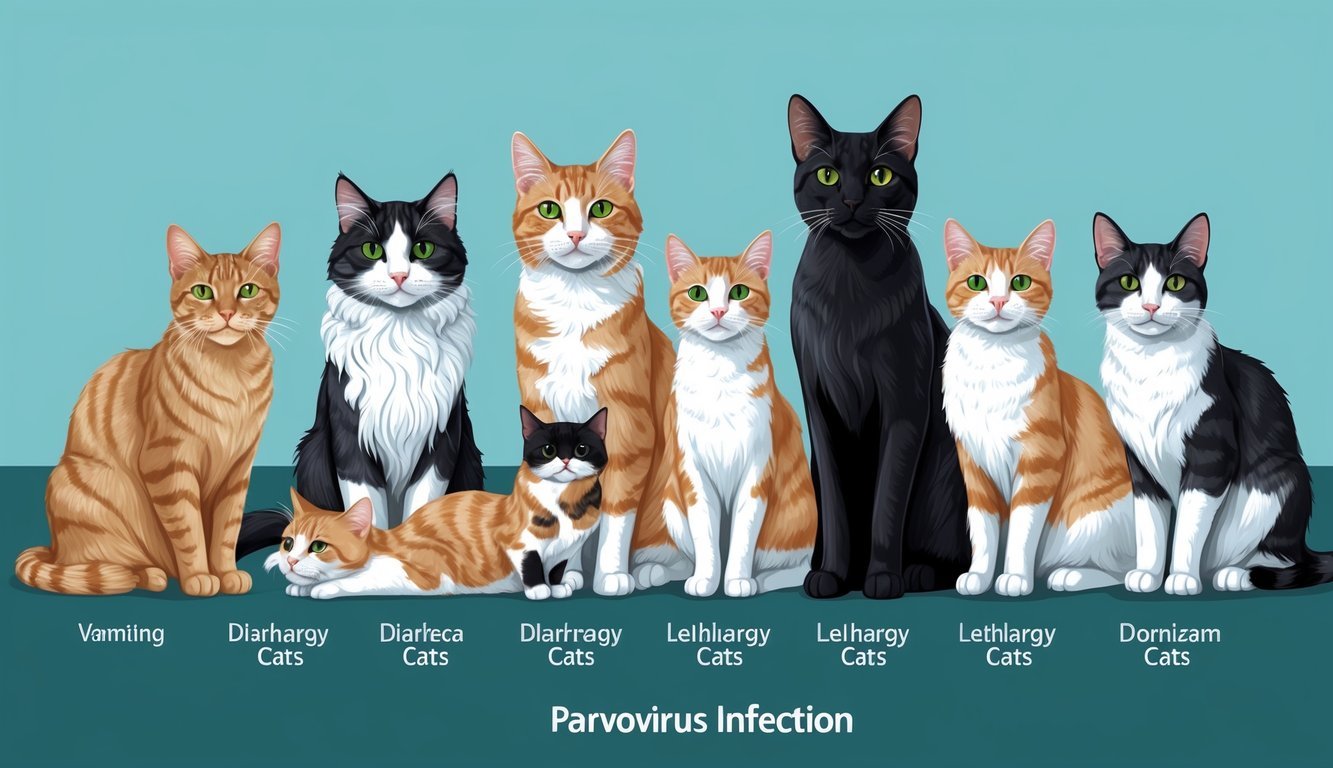
Certain groups of cats are more vulnerable to parvovirus infections.
It’s crucial to pay extra attention to these at-risk categories to ensure their health and safety.
Kittens and Unvaccinated Cats
Feline panleukopenia can have severe effects on kittens.
A young kitten’s immune system hasn’t fully developed, making it unable to mount an effective response against the virus.
Your best line of defense is vaccination.
Ensure that your kittens receive their vaccinations on schedule, as this significantly improves their chances of fighting off the virus.
Unvaccinated cats, regardless of age, are also at higher risk.
They can easily contract the virus from contaminated environments or other infected cats.
Regular health checks and monitoring for symptoms, such as lethargy or vomiting, are essential.
Early detection is key to managing the disease effectively.
Managing Parvo in Shelters
If you’re involved with shelters, managing parvovirus is critical.
High-density cat environments, like shelters, can see rapid spread of the virus.
To minimize contamination, implement strict cleaning protocols.
Use disinfectants that effectively kill the feline parvovirus on surfaces, bedding, and toys.
Isolation is another important tactic.
If a cat shows signs of infection, ensure it is separated from healthy cats immediately.
Provide proper care while keeping the infected cat away from others to prevent further outbreaks.
Educate staff and volunteers about recognizing symptoms early.
They should be trained to handle at-risk cats promptly.
This proactive approach can make a significant difference in the shelter’s overall health and safety.
Understanding the Impact
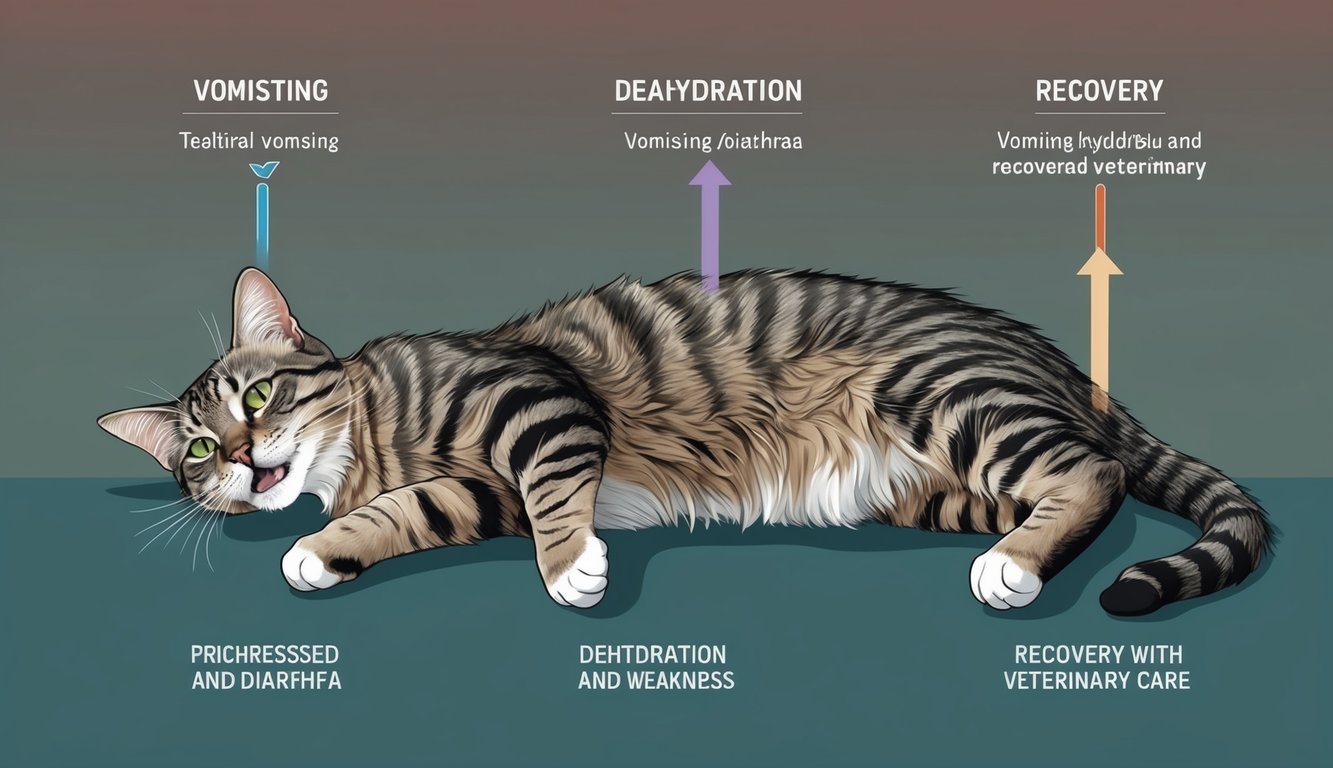
Parvovirus in cats, or feline panleukopenia, can have significant consequences on health, and understanding these effects is crucial for every cat owner.
The impact can vary widely, especially concerning mortality rates, recovery chances, and potential long-term health issues.
Mortality Rates and Recovery Chances
Cats infected with feline parvovirus face varying mortality rates, often depending on their age, health, and how quickly treatment begins.
Kittens, particularly those between 3 to 5 months old, are at a higher risk.
Without timely medical intervention, mortality can reach up to 90%.
With prompt veterinary care, many cats can recover.
Treatment typically involves supportive care, including hydration and nutrient support, which helps manage symptoms like severe diarrhea.
Recovery chances improve significantly with early detection, often enhancing the likelihood of a full return to health.
Long-Term Health Effects
Even after recovering from parvovirus, some cats may experience lasting effects.
One notable issue is cerebrovascular hypoplasia, a condition characterized by underdeveloped brain structures.
This can impact motor skills, leading to coordination problems.
Additionally, the virus’s damage to the intestinal lining can have longer-lasting effects.
Your cat may become more susceptible to gastrointestinal diseases, potentially leading to issues like malabsorption or recurrent infections.
Regular veterinary check-ups are vital to monitor any lingering health concerns and ensure your feline remains healthy in the long term.
Frequently Asked Questions
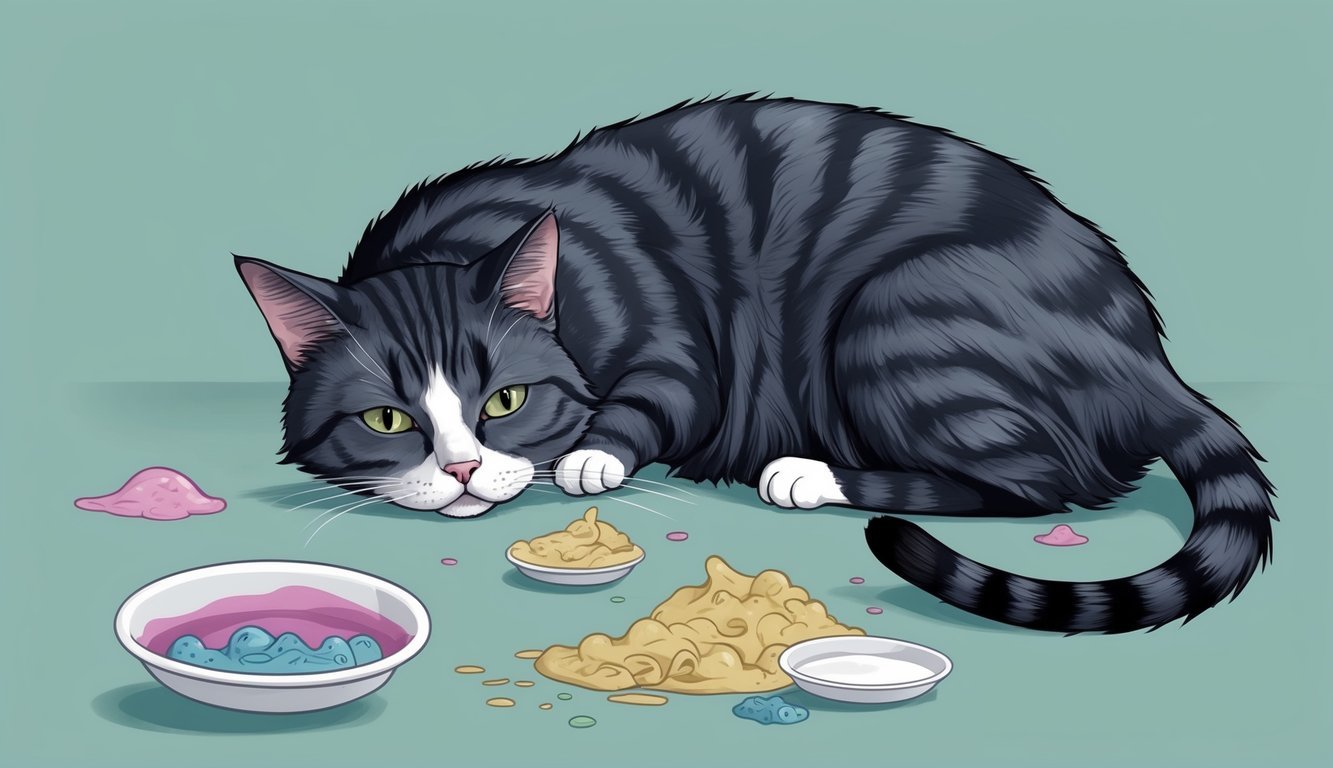
If you’re dealing with feline parvovirus, you likely have many questions.
Understanding the symptoms, treatment options, and progression of this virus can help you better manage your cat’s health.
What are the initial symptoms of panleukopenia in cats?
The first signs of panleukopenia often include lethargy, loss of appetite, and fever.
You may also notice vomiting and diarrhea, which can become severe.
Recognizing these symptoms early is crucial for effective treatment.
Can feline parvovirus be treated at home, and if so, how?
While some supportive care can be done at home, such as maintaining hydration and providing a bland diet, it is generally not advisable to treat feline parvovirus without veterinary supervision.
Professional care often includes hydration therapy and medications to manage symptoms.
During which stage is feline parvo most contagious to other cats?
Feline parvovirus is usually most contagious during the early stages.
Cats infected with the virus can shed it in their feces even before showing symptoms, spreading it to other cats in the environment.
What is the usual survival rate for cats with parvovirus?
Survival rates for cats with feline parvovirus can vary.
With prompt veterinary care, many cats can recover, but the rate can be lower in more severe cases.
Statistics suggest that with proper treatment, survival is possible for around 50% to 90% of affected cats.
How can I recognize the late stages of parvovirus in my cat?
In the later stages, your cat may exhibit severe lethargy, extreme dehydration, and persistent vomiting.
The diarrhea can also become more severe, possibly containing blood.
Recognizing these signs is important for seeking immediate veterinary attention.
Over what time frame does feline parvo typically progress?
Feline parvo usually takes about 7 to 14 days to progress from exposure to the onset of symptoms.
Once symptoms appear, the illness can rapidly worsen within a short period, making timely intervention critical.


